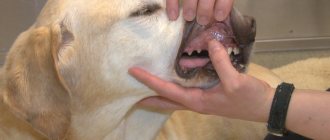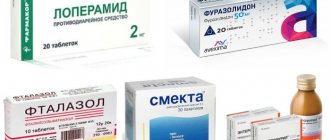Pet feces are not something that the owner is used to looking closely at. However, it can sometimes be used to judge the health status of the pet. If the stool looks like a soft, oblong substance that is dark brown in color, it is safe to say that your pet is normal. By consistency, shape and color you can judge the internal problems of the body. The most dangerous signal is the appearance of blood in the animal’s stool. If you notice that your pet is pooping blood, immediately take him to a specialist. Such a symptom does not mean anything good.
Why may blood appear in stool?
Typically, the presence of blood in dog excrement is associated with damage to the intestinal mucosa. The cause may be internal injuries, illnesses, etc.
1. Internal injuries.
If the intestines are damaged, the dog has no problems going to the toilet, does not suffer from diarrhea or constipation, and the presence of a wound can only be guessed by the color of the feces, as it turns either dark red or even black. The intestines can be damaged by sharp bones in food or swallowed small objects.
If the peritoneal organs are damaged, not only the color of the stool will change, but vomit of the same color will also appear. The dog will suffer from severe pain and may die not only from blood loss, but also from painful shock.
When dry nose is not associated with pathology, it goes away quickly. If the dog does not become lethargic, does not lose appetite, and there are no other alarming symptoms, then there is no need to worry.
2. Diseases of the digestive tract.
If a dog suffers from dysbacteriosis, blood and mucous streaks appear in its stool. The number of pathogenic bacteria grows, the internal balance is disrupted and inflammatory processes begin in the colon. In the acute form of the disease, bleeding increases.
Another disease with a similar symptom is hemorrhagic gastroenteritis. With it, inflammation affects both the intestines and stomach. The main signs of the disease are prolonged vomiting and diarrhea.
Also, the presence of bloody streaks in the stool and bleeding from the anus may indicate the presence of neoplasms and malignant tumors in some cases.
The most common cause of bloody stools is hemorrhoids. A sign of the disease is scarlet excrement. Most often, animals are susceptible to it, often suffering from constipation.
3. Helminths.
They cause harm to the mucous membranes, thereby causing bleeding. To prevent this cause, it is necessary to treat the dog with antiparasitic treatment every few months.
4. Infectious diseases.
Babies should be protected from parvovirus enteritis. This disease causes vomiting and loose, foul-smelling diarrhea. Without surgical intervention, the puppy may die within 3-4 days.
If your dog is not vaccinated and has watery stools with particles of mucus and blood, as well as a fear of bright light, you should urgently check it for the intestinal form of distemper. More typical symptoms of this infection include darkening of tooth enamel, the appearance of a white coating on the tongue, as well as a sour odor from the whole body. In its acute form, distemper kills a dog in just 1 day.
In addition, a similar symptom is caused by an atypical form of rabies, but the disease occurs without sudden changes in the animal’s mood. The disease develops up to six months, and its symptoms are similar to gastroenteritis.
5. Other reasons.
Additionally, it is necessary to mention the use of non-steroidal anti-inflammatory drugs. If you give them to your pet, it is better to consult a doctor to change the drugs. Some medications can cause stomach ulcers in your pet.
In addition, a dog can be poisoned by poisons or chemicals, having reached poison or household chemicals. In the acute course of the disease, bloody vomiting and convulsions, problems with coordination and a jump in temperature may appear. If you cannot get an appointment within a couple of hours, try to neutralize the poison yourself using an antidote.
Causes of the disease
How can you understand why a dog poops blood? Bleeding can develop as a result of injury or serious illness.
Types of diseases leading to bleeding in dogs:
- tumor;
- infectious;
- exchange;
- somatic.
There are 3 types of blood in a dog’s stool:
- scarlet blood in large quantities;
- streaks of blood;
- tarry liquid stool.
- white chair
List of diseases accompanied by bleeding in dogs:
- haemorrhoids;
- constipation, formation of anal fissures;
- infectious, toxic gastroenteritis;
- space-occupying formations in the stomach and intestines at any level, helminthiases;
- ulcers in the stomach, duodenum (duodenum);
- pancreatitis in a dog.
Associated signs indicating the disease
Sometimes red pigments in stool appear when eating red food, and in females during estrus, then no treatment is needed and the color of the stool returns to normal over time.
However, the following symptoms indicate more dangerous diseases:
- refusal to eat, weakness;
- diarrhea or vomiting;
- shallow rapid breathing;
- cough or discharge from the nose or eyes;
- pungent odor from stool, presence of mucus in it;
- lump in the abdomen;
- pallor of the mucous membranes;
- dry skin;
- exhaustion.
These symptoms are especially dangerous for puppies and small breed dogs, as they do not tolerate dehydration well. If any gastrointestinal ailments occur, you should immediately contact a veterinary clinic. If there is delay, the dog may simply not live to determine the causes of the disease and the onset of the disease.
Symptoms of the disease
The appearance of blood from your pet's anus can indicate various diseases. Therefore, it is important to know the main symptoms of this disease.
Typically, dog poop is light or dark brown in color. If blood impurities appear in them, this is very serious and indicates failures or internal damage. Thus, bright scarlet veins may indicate damage to the large intestine, in particular in the rectum.
If blood discharge changes the color of the stool to dark, almost black, then one can judge that there is a disorder in the upper gastrointestinal tract.
It happens, although rarely, that an animal develops diarrhea mixed with blood. This may indicate severe poisoning or serious problems with the gastrointestinal tract.
What to do?
It is quite clear that if you discover blood impurities in your pet’s stool, you should immediately show him to the veterinarian. In this case, you should not show independence. But the faster you do this, the more chances he will have to recover.
If you cannot do this right away, then first of all, provide your pet with rest and apply a cold compress to the abdomen and sacrum. Under no circumstances should you feed him, give him a laxative, or give him an enema!
The appearance of blood in the stool almost always indicates the seriousness of the illness, the real cause of which can only be determined by a veterinarian after performing the necessary examinations. For the dog owner, only an auxiliary function remains. For example, therapy for rectal bleeding involves a high-quality and balanced diet, timely examinations by a specialist and monitoring the nature of bowel movements.
Determining the diagnosis in a veterinary clinic
The doctor will prescribe treatment that will help eliminate the causes of blood clots in the stool. In addition to collecting information about the dog’s life and examining it, you will also have to:
- donate blood, urine and feces to determine the presence of infection in the animal’s body;
- perform an ultrasound to exclude the possibility of tumors and polyps in the gastrointestinal tract;
- do an x-ray and endoscopy to evaluate the mucous membranes.
Based on the results of this study, the veterinarian will either prescribe medications or send for surgery. You should not give your dog any medications before receiving a diagnosis, but exceptions are possible if there is severe pain or other severe symptoms.
Diagnosis and treatment
The veterinarian will perform the following procedures to determine the cause of bleeding: medical history, external examination, laboratory tests (blood, feces, urine), radiography, ultrasound of the abdominal organs, biopsy, if necessary, colonoscopy, gastroscopy. Therapeutic measures:
- Eliminating the cause. Medicines are prescribed depending on the established diagnosis. In some cases, for example, with malignant neoplasms, surgical intervention is required.
- Hemostatic agents – Dicynon, Vikasol, Etamzilat, suppositories – Relief, Procto-glivenol.
- Blood replenishment - glucose solutions, Ringer's, Poliglyukin, Perftoran, in severe cases - blood transfusion.
- Antibiotics, drugs to eliminate inflammation, ulcers - according to indications.
- Special diet - easily digestible food, balanced in vitamin and mineral composition.
- Enemas, rinses when prescribed by a veterinarian.
What is the danger of internal bleeding
Loss of blood leads to the development of anemia in the animal, and due to low blood pressure and constant weakness, the dog is less able to tolerate any stress on the body and becomes drowsy. Without proper care and treatment, your pet may develop problems with the functioning of its organs. The worst-case scenario is the death of your pet.
The cause of death can be too much blood loss, dehydration, intoxication and exhaustion. In all these cases, you will need the help of a specialist.
Examination and diagnosis
Determining the severity of the disease in an animal and its severity involves a number of examinations:
- visual inspection of the dog;
- stool examination;
- examination of the rectum;
- ultrasound diagnostics of the peritoneum;
- performing a colonoscopy or gastroscopy (depending on the color of the blood impurity).
For a correct diagnosis, the information that is required from the dog owner also matters a lot:
- timing of the onset of symptoms of the disease;
- whether deworming was carried out in a timely manner and when;
- what kind of diet does the pet have (does it chew bones, picks up food or other objects from the ground);
- does he suffer from loss of appetite, etc.
Based on all this, a diagnosis is established, and a treatment regimen is determined accordingly. Elimination of blood from stool is possible only if the root cause that caused such a symptom is cured. Therefore, do not delay your visit to the veterinary clinic with your four-legged friend. Not only his health, but possibly his life will depend on the speed of your actions.
Hemorrhoidal bleeding
In adult dogs, varicose hemorrhoids develop as a consequence of labor and regular constipation. When these nodules are injured by hard feces, intense bleeding develops. In this case, the feces are intensely stained with fresh blood due to its large amount. Blood loss is regular, significant and leads to anemia. A dog's feces with blood scare everyone, but the bleeding stops on its own. It is necessary to urgently seek help from a veterinary hospital to prescribe adequate therapy and eliminate the risk of recurrent hemorrhage.
In case of rectal prolapse, the diagnosis is not difficult, since the defect is visible to the naked eye. When prolapsed, the intestine is visible from the anus, is easily injured, and bleeds slightly. Most often it is a complication of constipation and bladder stones. Immediate contact with a veterinarian is necessary, because the intestinal wall may be pinched, blood flow stops, and necrosis develops. This situation requires emergency surgery.
Infectious, toxic gastroenteritis
The mechanism of development of gastroenteritis with bleeding is the same during infection or damage to the gastrointestinal tract and is explained by the release of toxic products into the intestinal lumen. It often develops in puppies when they are improperly kept in a cold room or improperly fed, which lead to a decrease in immunity.
When an infectious agent or endogenous toxins is attached, for example against the background of pyelonephritis, the mucous membrane of the gastrointestinal tract becomes edematous. Exposure to food masses, gastric juice, and pancreatic enzymes injures the delicate mucous membrane, and the dog poops blood. The severity of bleeding varies. The less pronounced the bleeding, the more dangerous it is for the dog, since it does not get to the veterinarian sooner, but only after complications develop.
As the disease progresses, the dog develops diarrhea with blood. She refuses to eat, becomes lethargic and apathetic, hides in secluded places, and periodically moans. If a dog has diarrhea with blood, then I should treat it myself; I need to urgently consult a doctor, undergo a full examination aimed at finding the source of bleeding, the cause of the disease, and select individual therapy and diet.
Tumors of the gastrointestinal tract, helminthiases
With a long-term oncological disease of the gastrointestinal tract, the tumor growing into the lumen of the organs is constantly injured by feces and gradually begins to bleed. The severity of bleeding varies. It must be remembered that blood in the stool may not be visible to the naked eye. Hidden bleeding is also dangerous for the body, as it indicates a serious pathology. Therefore, it is necessary to undergo preventive examinations by a veterinarian.
If a dog poops blood due to tumor diseases, then it is too late to ask the question of what to do. Regular examination of the dog by a veterinarian is necessary, which will allow diagnosing the disease at an early stage and preventing its progression and the development of complications. Helminthic infestation - eimeriosis develops more often in puppies at the age of 2-3 months, leading to the appearance of blood streaks in the stool.
Ulcers are the cause of bleeding
Ulceration in the stomach and duodenum with a complicated course leads to bleeding. Intense ulcerative bleeding from the stomach is accompanied by bloody vomiting. But blood loss of about 200 ml will not cause vomiting. A transformation of the blood occurs as a result of the work of enzymes and intestinal bacteria, and the dog develops tarry black liquid or mushy sticky feces. In this situation, immediate consultation with a doctor is necessary.
Feeding dogs with diarrhea
In the first 24 hours after bloody substances appear in the stool, you should stop feeding the dog anything and give only clean water. The dog must drink a lot; if it refuses, you will have to force it. Refusal to drink can lead to dehydration.
If the diarrhea has stopped and your dog's stool no longer looks unhealthy, you can give your pet a small amount of boiled rice. The dog should be fed such small portions 4-5 times a day, increasing the portion with each meal. In addition to rice, you can give fermented milk products (but also in small quantities). Two to three days of such nutrition - and you can return to your usual diet (but only on the condition that the diarrhea has completely stopped).
Treatment
The following basic activities are required:
- If possible, eliminate the causes of the disease.
- Hemostatic agents.
- Replenishment of circulating blood volume.
- Detoxification therapy.
- Maintains liver and kidney function.
- Prevent your dog from eating feces.
- Antibacterial, anti-inflammatory drugs according to indications.
- Compliance with diet.
- Local treatment in the form of enemas, gastric lavages, if prescribed by a veterinarian.
Prevention after recovery consists of regular examinations by a veterinarian, preventive vaccinations, anthelmintics, and proper nutrition to avoid relapses.
source
Hemorrhages in dogs - types, causes, first aid
The process of blood leaving the lumen of the vascular walls due to a violation of their structural integrity is called bleeding. Blood can flow out in small droplets, flow in a continuous stream, or flow under powerful pressure. Blood loss can be insignificant or measured in liters.
The type of damaged vessel determines the degree and type of bleeding. There are venous, arterial, capillary and mixed bleeding. The appearance of bleeding coincides with the onset of damage factors or remains hidden for several days. In such cases, primary or secondary hemorrhage is distinguished.
There is also a distinction between external and internal bleeding. External hemorrhage is when blood flows freely out. When blood accumulates in a body cavity under pressure, called extravasation, the bleeding will be internal.
More often, dogs are diagnosed with internal hemorrhage, which is dangerous because it cannot be detected for a long time and the pathological process occurs in the initial stages, almost asymptomatically. External bleeding is easier to diagnose and take measures to eliminate it.
It is extremely important for the dog owner to promptly detect the characteristic symptoms of bleeding. In the future, this will help prevent the development of complications and death of the pet.
First aid for bleeding
Internal bleeding in a dog cannot be stopped at home without experience and without knowing the exact reasons for the development of the pathological condition. If characteristic signs are detected, the owner should immediately contact a veterinary hospital for help.
The doctor develops treatment tactics only after making a diagnosis and assessing the general condition of the patient. Depending on the type of bleeding (venous, arterial, capillary), a set of measures is prescribed.
Symptoms of internal bleeding in a dog, unlike external bleeding, do not appear immediately, but several hours or days after the onset.
If a dog is bleeding from the nose, it is necessary to limit the pet from any active movements. Sudden head movements increase blood flow and provoke the appearance of copious discharge. A cold compress is applied to the back of the nose. This will only help if the bleeding actually occurred due to injuries to the nasal mucosa.
Pulmonary and intestinal bleeding, manifested by hemorrhage from the nasal passages, cannot be stopped in this way. It is necessary to take the animal to a specialist as soon as possible.
External venous bleeding is stopped by applying a bandage. Apply a pressure bandage to the wound and bandage it tightly. The pet must be delivered to the clinic within 2-3 hours.
Arterial bleeding requires applying a tourniquet or tight bandage not to the wound, but above the damage. For these purposes, you can use available items - a collar, a tourniquet, a belt.
In case of capillary bleeding, it is enough to apply cold to the damaged area. The lumen of the damaged capillary narrows under the influence of cold, stopping the hemorrhage.
Bleeding in a dog after birth requires the intervention of a veterinarian. Stopping hemorrhage using home methods is not practical. This is due to the fact that the clinical picture can only worsen, and the animal’s condition will reach critical levels.
Prevention
In order to prevent the development of hemorrhages in dogs, it is necessary to follow a number of basic rules. Avoid mechanical injuries to the animal, which become the basis for the development of dangerous internal bleeding. It is also important to promptly treat all infectious and systemic diseases.
Particular attention should be paid to females during the period before and after the birth process. Lethargy and apathy, refusal of water and food, can be signs of internal bleeding in a dog. You should not self-medicate, but play it safe and consult a veterinarian.
Source: https://zen.yandex.ru/media/ivethelp/gemorragii-u-sobaki-vidy-prichiny-pervaia-pomosc-5db41a5d98930900b13420cd
The dog is bleeding from the anus: causes and treatment
The condition of feces is a clear sign of your pet’s health. If a dog is bleeding from the hind pancreas, there are no traces of blood in the stool. Sometimes this is a sign of damage to the rectum or anus. In this case, the symptom is not very disturbing. This usually occurs when the anal glands become enlarged.
Mechanical damage is more dangerous when blood clots are passed through the stool. This happens due to serious injury to internal organs, for example, due to being hit by a vehicle. Complicated childbirth can cause bleeding.
The reasons listed earlier are mechanical in nature. The remaining factors are divided into tumor, infectious, and metabolic types of diseases.
Typically, stool is accompanied by the release of large quantities of scarlet blood, blood streaks or black coloration. The latter type indicates internal bleeding, which led to blood clotting as it moved through the intestines. The main reasons that a dog is bleeding from the anus:
- Development of helminths.
- itching in the anus, causing the dog to rub it against hard surfaces;
- pain syndrome;
- altered gait;
- refusal of food, walks;
- lethargy, weakness, inactivity;
- dulling of the coat;
- exhaustion.
The appearance of blood in the stool is particularly influenced by hookworms - parasites, digestive disorders: diarrhea, diarrhea, vomiting, and sometimes constipation;
If such signs are detected, the owner is advised to remember them to help the doctor make a diagnosis.
Types and causes of bleeding in dogs
- This type of bleeding occurs mainly due to trauma to the nose. The blood may flow in a small stream or flow from the nostrils in large drops. With this type of bleeding, first of all, it is necessary to calm the pet, and also try to protect it from sudden movements and running. Any sudden body movement can provoke an increase in blood flow. Then a cloth soaked in cold water or ice should be placed on the animal’s head. After taking priority measures, you must take your pet to a veterinarian, who will diagnose the injury and further treat the dog.
- Another cause of nosebleeds may be pancreatitis. The disease is very dangerous, therefore, if you are absolutely sure that the dog has not knocked anywhere, you must urgently take it to the veterinarian.
- Such bleeding occurs after a fall from a great height, being hit by a car or other serious injuries to the sternum, or due to various lung diseases that have become chronic. In this case, blood comes out of the animal’s mouth or nose, and the bleeding process is usually accompanied by a strong bloody cough. As in the case of nosebleeds, first of all, the animal must be immobilized and a veterinarian must be urgently called. If for any reason this is not possible, you need to take action yourself. To do this, you will need to inject the animal with 2 milliliters of Vikasol, slightly tighten the dog’s chest, and also pour approximately 10 milliliters of calcium chloride into its mouth. You can also give your dog a dozen drops of any heart remedy. The procedure should be repeated every 6-7 hours. However, all of the above measures are not effective enough, so the dog should be taken to the hospital within half a day.
- In most cases, it occurs due to diseases of the oral cavity, fractures or simply injuries to the jaw, which are accompanied by tooth loss.
Why does my dog's anus bleed?
If the dog has been bleeding from the mouth for quite a long time, you need to make a cotton swab and place it between the jaws. This must be done in such a way that it closes the space where the missing or damaged tooth is and puts light pressure on it. The cotton roller must be absolutely clean.
For safety and greater effectiveness of the procedure, it can be moistened with Vivaton gel. In order to properly fix your pet's jaw, you will need to hold it with your hands or tighten it with a rope made from a bandage that is not too tight.
If the injury is severe enough to cause severe pain, your dog may be given pain medication.
- Most often it is caused by foreign bodies entering the stomach, intestinal injuries, as well as various gastrointestinal diseases. Bleeding that is not too severe can be detected by noticing that the animal's feces have become tarry. If the bleeding is heavy enough, the dog defecates much more often. In this case, the feces themselves become almost black. When trying to provide first aid to a dog, you should take into account the fact that, first of all, it needs complete rest. Having secured it, you need to put something cold on your stomach and area of the cross. You should not give the animal food, give an enema, or try to influence its condition in any other way. The animal must be taken to the hospital immediately.
- There are many types of hematemesis. Hungry vomiting once before eating is normal for dogs and should not cause much concern. But if it recurs at least 2 times, you need to urgently consult a doctor - most likely, such a disorder is caused by a violation of the bacterial background of the gastrointestinal tract, serious liver diseases, pancreas, or parasitic infestation (worms entering the dog’s body). The following features should also be taken into account: scarlet vomiting occurs in diseases of the esophagus, and if the problem is in the stomach, the blood will be dark red. In any case, if your dog is vomiting blood, you should consult a doctor who will prescribe appropriate treatment.
- The danger of this bleeding lies in the fact that the owner cannot always notice it. Typically, the degree to which blood stains the stool (the stool becomes tarry and dark red in color) depends on how much internal bleeding there is in the stomach or small intestine. It is usually caused by severe damage to the rectal lining, disease or prolapse of the rectum, hemorrhoids or tumors. The owner's behavior after detecting this symptom should depend on the cause of its occurrence. If the bleeding is slight, there is a high chance that it is caused by constipation. Try giving the animal a little castor oil and feeding it oatmeal with milk, completely eliminating meat and fish products. If the bleeding is severe enough and does not stop for several days, you should take your pet to see a doctor. Only a specialist can correctly diagnose the disease that caused the symptom.
- The appearance of blood in the urine most often means that the dog has kidney problems, urinary tract disease or bladder disease. Depending on the underlying medical condition causing the symptom, your dog may have an increased urge to urinate, or it may be painful. If you notice any of the above signs, you should definitely take your dog to a clinic where he can get help. But if the situation is critical, and there is no opportunity to visit a doctor, you need to put something cold on the dog’s lower back and give him approximately 100 milliliters of nettle to drink. No-spa, calcium chloride or Vikasol can also help (must be administered intramuscularly).
- Most often, this type of bleeding is caused by injuries, tumors, inflammation of the uterus, or is a consequence of childbirth and various types of hormonal imbalances. If the blood loss is not too profuse, the dog usually manages to lick off drops of blood before the owner notices. If it is strong enough, the blood may flow in a small stream and blood stains will remain where the dog was lying. Uterine bleeding is not always accompanied by any other symptoms. If the bleeding is severe, the animal may become lethargic and apathetic; often in such cases, dogs refuse water. In any case, after uterine bleeding is detected, the dog should be taken to a doctor as soon as possible. If this is not possible, you need to give your pet warm milk or low-fat chicken broth, put something cold on the belly and, if necessary, inject 2 milliliters of Vikasol.
Source: https://kishechnik-zhivot.ru/simptomy/u-sobaki-krov-iz-zadnego-prohoda-prichiny-i-lechenie
Causes of bloody diarrhea in dogs
Diarrhea is characterized by frequent passage of watery stool. Due to various reasons, their consistency and composition may vary, and include foamy substances, blood, mucus, etc.
If you notice that your pet often passes loose stools, you need to find out the cause of this ailment in order to cure the dog as soon as possible. If the problem is left unchecked, over time, diarrhea can lead to exhaustion, dehydration and electrolyte imbalance.
Diarrhea lasting more than 2 weeks is especially dangerous for pregnant and lactating dogs, as well as puppies.
In many cases, the cause of bloody diarrhea in a dog can be determined independently by paying attention to the color, consistency and general appearance of loose stools:
- Digested blood will cause black, liquid, slimy, tar-like stool in pets. This occurs due to bleeding in the upper gastrointestinal tract.
- Bleeding in the lower gastrointestinal tract (in the colon) will provoke the release of loose stool with blood. Blood leaves the intestines undigested.
- In case of acute inflammation in the digestive tract, a dog may produce mucous, liquid stools with foam and bloody bodies (inclusions, clots, threads). At the same time, the stool has a healthy color.
Why can dogs have bloody diarrhea?
There can be many causes of bloody diarrhea in a dog. Let's list some of them:
- Worm infestation.
- Food poisoning.
- Foreign objects or inflammation in the gastrointestinal tract. Objects with thick corners can damage the gastrointestinal mucosa and cause traumatic enterocolitis.
- Tumors in the colon.
- Mechanical injuries.
- Chronic ailments associated with the liver or pancreas.
- Invagination of the walls of the colon.
- Parasites, protozoal diseases.
- Diseases caused by bacteria or viruses (parvovirus enteritis, atypical rabies, letospirosis, intestinal infections).
- Salmonellosis. Accompanied by the appearance of ulcers on the walls of the intestines and other organs of the gastrointestinal tract.
- Chemical poisoning. Your pet may pick them up on the street.
- Dysbacteriosis. The intestinal mucosa can be damaged by pieces of undigested food.
With the above conditions, a number of other symptoms may be observed, in addition to the appearance of bloody stool:
- lack of appetite;
- anemia;
- colic;
- heat;
- arrhythmia;
- the abdominal walls are tense;
- dehydration, sunken eyes, skin becomes less elastic, coat becomes duller in color.
If the cause of bloody diarrhea is in the upper gastrointestinal tract (stomach), the stool will be scarlet, in the lower part (in the colon) it will be black.
Salmonellosis
An acute disease most often encountered by young dogs. They can catch it through nutrition (through food) or by contact with another infected animal. The incubation period ranges from 1 to 7 days. In addition to bloody diarrhea, this disease causes other characteristic symptoms:
- weight loss;
- lack of coordination;
- vomiting mucus;
- lack of appetite;
- temperature increase.
When the first signs of the disease appear, you should immediately contact a veterinary clinic, since without treatment the dog will not last even 2-3 days after the first symptoms appear.
The disease occurs in two forms: subacute and chronic. The first is characterized by less pronounced disorders of the gastrointestinal tract, but wheezing in the lungs and rhinitis become noticeable. The second form is characterized by bronchopneumonia, discharge of pus from the nose, frequent discharge of liquid bloody and mucous feces, refusal to feed and wheezing in the lungs.
Parvovirus enteritis
An acute viral disease, especially dangerous for small puppies aged 2 months to one and a half years. Most of these diseases lead to death, so the puppy must be treated immediately. The incubation period ranges from 4 to 10 days, but the dog can become dangerous to others within 3–5 days after infection.
The disease can be fulminant or acute, and occur in different forms: cardiac, intestinal and mixed. If a puppy under 2 months of age gets sick and the disease progresses lightning fast, death occurs a few hours after the first symptoms appear. In the acute form, an admixture of blood appears when stool is excreted (initially the stool becomes gray, then acquires a green or purple tint). Symptoms:
- dehydration;
- shock;
- the dog vomits foam (mucus);
- the mucous membrane of the gastrointestinal tract bleeds;
- myocardial inflammation;
- decreased leukocyte levels;
- weight loss;
- leukopenia.











